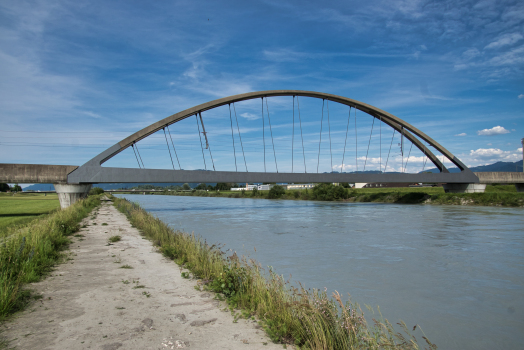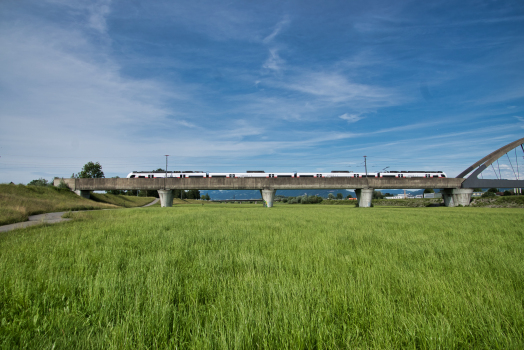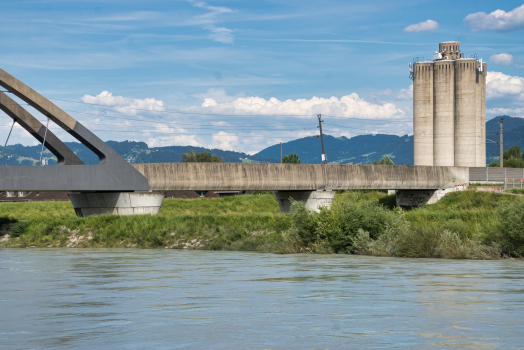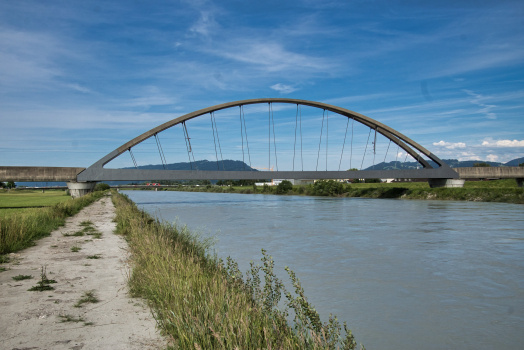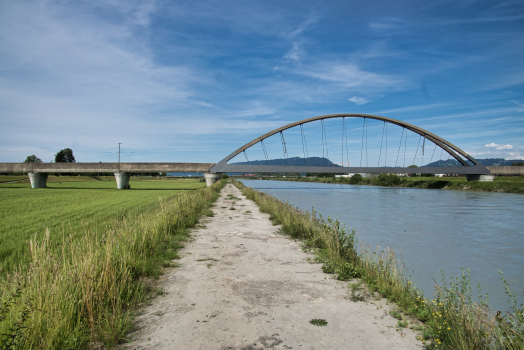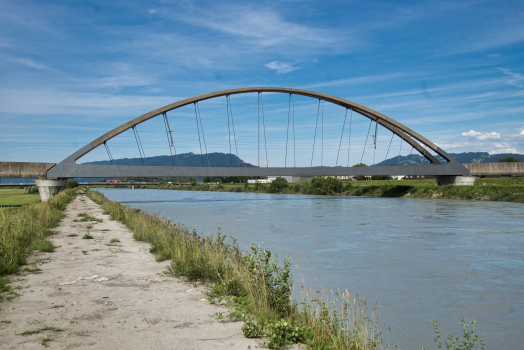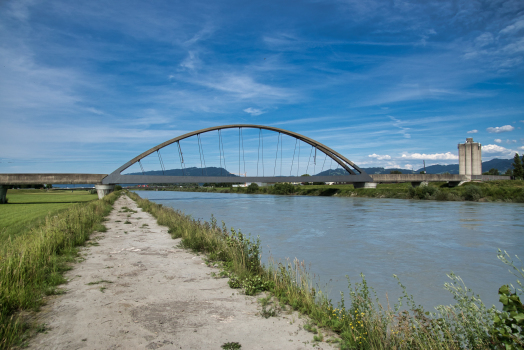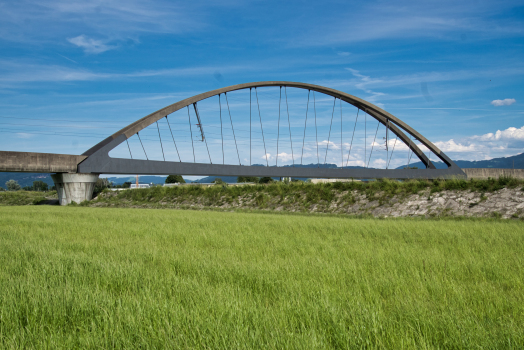General Information
| Completion: | March 2013 |
|---|---|
| Status: | in use |
Project Type
| Structure: |
Tied-arch bridge with inclined hangers |
|---|---|
| Function / usage: |
Railroad (railway) bridge |
| Material: |
Steel-reinforced concrete composite bridge |
| Plan view: |
Structurae Plus/Pro - Subscribe Now! |
| Support conditions: |
Structurae Plus/Pro - Subscribe Now! |
| Material: |
Structurae Plus/Pro - Subscribe Now! |
Awards and Distinctions
| 2015 |
entry
for registered users |
|---|
Location
| Location: |
Sankt Margrethen, Saint Gallen, Switzerland Lustenau, Vorarlberg, Austria |
|---|---|
| Crosses: |
|
| See also: |
Sankt Margrethen Rail Overpass (2013)
|
| Coordinates: | 47° 26' 51.75" N 9° 39' 28.22" E |
Technical Information
Dimensions
| total length | 276.5 m | |
| span lengths | 24.10 m - 2 x 26.20 m - 28.97 m - 102 m - 28.98 m - 24.12 m | |
| number of spans | 7 | |
| number of tracks | 1 | |
| track gauge | 1 435 mm | |
| track gauge | 1 435 mm | |
| abutments | number | 2 |
| piers | number | 6 |
Materials
| piers |
reinforced concrete
|
|---|---|
| arches |
reinforced concrete
|
| deck slab |
reinforced concrete
|
| abutments |
reinforced concrete
|
| main girders |
steel
|
ÖBB Rhine Bridge near Lustenau
Task definition
On behalf of the Austrian Federal Railways (ÖBB), the structural design for the new construction of the single-track cross-border railroad bridge over the Rhine near Lustenau was to be prepared. The railroad bridge connects the Swiss canton of St. Gallen with the Austrian state of Vorarlberg and is located on the St. Margrethen (CH) – Lauterach (A) section of the line, which is part of the international railroad line Zurich – Bregenz – Munich.
The design of the new bridge includes the project phases of submission (bilateral, Austria and Switzerland), tendering and execution.
The boundary conditions for the planning of the new railroad bridge were the improvement of flood protection and a reduction in travel time on the Austrian railroad section. For the implementation of the specifications of the International Rhine Regulation (IRR) for flood protection on the Rhine with a future discharge capacity of 4,300 m³/s, the lower edge of the bridge had to be raised by two meters compared to the existing structure and planned smoothly in order to avoid snarls. Due to railroad operational requirements on the existing railroad line and in order to achieve the specified travel time reduction, the new alignment had to be shifted by about 12 m to the south. This resulted in an increase in line speed from the previous 60 km/h to 100 km/h. In intensive cooperation with the International Rhine Regulation (IRR), the state of Vorarlberg, the Swiss authorities, but also with the technical services of the ÖBB, the steel construction consultant, the metallurgist, the concrete technologist, as well as with the architect, all boundary conditions could be well implemented in the planning of the aesthetic structure.
Description of the construction
The new railroad bridge over the Rhine consists of a total of seven single-track single-span structures on deep-foundation substructures. The total length of the bridge chain is 276.50 m. The centerpiece is an arch bridge with an innovative composite structure spanning the main drainage channel of the Rhine. The span of the arch bridge is 102 m, the arch span is 19.95 m. Foreshore bridge structures in the form of reinforced concrete troughs adjoin the arch bridge on both sides. The cantilever girder of the arch bridge structure consists of two main steel girders running parallel to the track, the steel end cross girders and the transverse-tensioning in-situ concrete deck slab connected to the main girders in a flexurally rigid manner. The superimposed arch in reinforced concrete construction is clamped in the steel arch feet of the two main girders, whereby the horizontal thrust of the arch structure is directly introduced into the stretch girder structure. The arch axes each lie in one plane and are inclined to each other in the longitudinal direction of the bridge. The concrete stiles leading out of the steel arch feet merge towards the apex of the arch. The shape of the curved outer web plates of the main girders is derived from the projection of the mutually inclined arch stems into the ground plan. Due to the chosen design, these plates lie on a conical shell and can be unwound. In the longitudinal direction of the bridge, this design principle results in a variable width of the welded and airtight steel main girders. Between the arch and the stretch girder, 24 spatially inclined, upset-forged and non-tensioning hangers with a diameter of 100 mm (solid steel sections in S355NL) are arranged. These upset-forged hangers were used for the first time on a railroad bridge.
Choice of construction materials
During the design process, great importance was attached to the choice of construction materials in terms of economy, durability and in accordance with their favorable material properties. Therefore, the main girders of the arch bridge, which are mainly subjected to tensile stress, were made of steel, while the arch, which is mainly subjected to compressive stress, was made of concrete. The connection of the compression-forged hangers to the main girder stresses the top chord plate in the thickness direction and was investigated in detail because of the associated risk of terrace fracture. Higher requirements were placed on the Z-value and on the chemical composition of the steel plate, the welding sequences were selected favorably and the welds were ground. A metallurgist was also consulted during the design phase for the proper selection of the plate properties (S355ML + Z35 with sulfur ≤ 12 ppm).
Special engineering achievement
The new arch bridge over the Rhine near Lustenau was designed using an innovative composite construction method. The combination used of the individual structural elements of steel main and end cross girders, concrete deck slab and superimposed concrete arch make the structure unique and, moreover, easy to inspect and maintain. The upset-forged hanger connection is a completely new system for railroad bridges and was used here for the first time. The main advantage is that the hanger connection is designed with a continuous and notch-free transition to the connecting plate of the bridge girder and is produced very simply with only one horizontal weld. The weld is easy to rework, easy to inspect, and not very susceptible to fatigue.
Explanatory report by Bernard ZT GmbH for submission to the Ulrich Finsterwalder Ingenieurbaupreis 2015
Participants
-
ÖBB Infrastruktur AG
- Hannes Kari (designer)
- Zedlacher (expert)
- Josef Fink (expert) (steel)
- Oswald Neuner (substructure)
- Schaur ZT-GmbH (superstructure)
Relevant Web Sites
There currently are no relevant websites listed.
Relevant Publications
- (2013): Die neue ÖBB-Rheinbrücke bei Lustenau, Österreich - Ein außergewöhnliches Bogenbrückentragwerk. In: Stahlbau, v. 82, n. 5 (May 2013), pp. 340-346.
- About this
data sheet - Structure-ID
20065957 - Published on:
07/02/2014 - Last updated on:
22/06/2024

